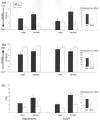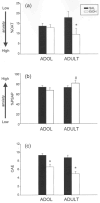Developmental differences in acute ethanol withdrawal in adolescent and adult rats
- PMID: 17760786
- PMCID: PMC2644064
- DOI: 10.1111/j.1530-0277.2007.00457.x
Developmental differences in acute ethanol withdrawal in adolescent and adult rats
Abstract
Background: Withdrawal from an acute high ethanol dose induces behaviors reminiscent of withdrawal from chronic ethanol exposure. While such "hangover"-related anxiety has previously been shown to be considerably less pronounced in adolescent compared to adult male rats, ontogenetic studies are limited and few experiments have directly compared sex- and age-related differences in sensitivity to ethanol hangover.
Methods: The current experiments examined consequences of a previous ethanol challenge (4.0 g/kg i.p. injection, 20% v/v) on anxiety and exploratory behavior in the elevated plus-maze (EPM) and holeboard (HB) tests, respectively, in adolescent and adult male and female Sprague-Dawley rats.
Results: In Exp. 1, evidence of hangover-related anxiety and withdrawal-induced hypoactivity emerged at both ages and in both sexes. As several procedural variables were changed in Exp.1 relative to previous studies from our laboratory showing age-related differences in these hangover measures, Exp. 2 explored the possible contribution of 2 variables to ontogenetic expression of withdrawal-induced anxiogenesis: (1) isolation vs. social context during the postchallenge recovery period and (2) EPM testing alone or immediately following a 5 minute HB test. Results of Exp. 2 revealed few significant interactions of these variables with age- and ethanol exposure-related anxiety measures, although sequential testing (HB before EPM) notably suppressed activity in the EPM and altered the major underlying component of EPM behavior from anxiety to activity as revealed in factor analyses of these data. Additional analyses conducted on animals tested only in the EPM revealed attenuations in withdrawal anxiogenesis among adolescents, along with withdrawal-related decreases in activity at both ages.
Conclusions: Taken together, these results suggest that adolescents do show an attenuated sensitivity to hangover-induced anxiogenesis in the EPM, an age difference not evident under other pretest conditions. Therefore, caution should be exerted when using the EPM to index anxiety across age. The robustness of withdrawal-related hypoactivity at both ages suggests that adolescents may not be globally insensitive to the consequences of previous binge-like exposure to ethanol, but rather less likely to express certain hangover-related consequences.
Figures



Similar articles
-
Acute ethanol withdrawal (hangover) and social behavior in adolescent and adult male and female Sprague-Dawley rats.Alcohol Clin Exp Res. 2004 Jan;28(1):40-50. doi: 10.1097/01.ALC.0000108655.51087.DF. Alcohol Clin Exp Res. 2004. PMID: 14745301
-
Dose- and time-dependent expression of anxiety-like behavior in the elevated plus-maze during withdrawal from acute and repeated intermittent ethanol intoxication in rats.Alcohol Clin Exp Res. 2007 Nov;31(11):1811-9. doi: 10.1111/j.1530-0277.2007.00483.x. Epub 2007 Sep 14. Alcohol Clin Exp Res. 2007. PMID: 17877783 Free PMC article.
-
Anxiogenic effects during withdrawal from acute ethanol in adolescent and adult rats.Pharmacol Biochem Behav. 2003 May;75(2):411-8. doi: 10.1016/s0091-3057(03)00134-5. Pharmacol Biochem Behav. 2003. PMID: 12873633
-
Effects of chronic intermittent ethanol exposure during early and late adolescence on anxiety-like behaviors and behavioral flexibility in adulthood.Behav Brain Res. 2020 Jan 27;378:112292. doi: 10.1016/j.bbr.2019.112292. Epub 2019 Oct 15. Behav Brain Res. 2020. PMID: 31626849 Free PMC article.
-
Anxiety-like behaviors following chronic ethanol exposure.Neurosci Biobehav Rev. 2005 Jan;28(8):837-50. doi: 10.1016/j.neubiorev.2004.11.001. Epub 2004 Dec 10. Neurosci Biobehav Rev. 2005. PMID: 15642625 Review.
Cited by
-
Clinical Characteristics and Treatment Outcomes of Alcohol Withdrawal Syndrome in Adolescents and Young Adults.JAACAP Open. 2024 Mar 25;3(2):216-231. doi: 10.1016/j.jaacop.2024.01.012. eCollection 2025 Jun. JAACAP Open. 2024. PMID: 40520978 Free PMC article.
-
Male, but not female, Sprague Dawley rats display enhanced fear learning following acute ethanol withdrawal (hangover).Pharmacol Biochem Behav. 2021 Sep;208:173229. doi: 10.1016/j.pbb.2021.173229. Epub 2021 Jul 8. Pharmacol Biochem Behav. 2021. PMID: 34246729 Free PMC article.
-
Different affective response to opioid withdrawal in adolescent and adult mice.Life Sci. 2009 Jan 2;84(1-2):52-60. doi: 10.1016/j.lfs.2008.11.002. Epub 2008 Nov 12. Life Sci. 2009. PMID: 19032959 Free PMC article.
-
Adolescent brain development and underage drinking in the United States: identifying risks of alcohol use in college populations.Harv Rev Psychiatry. 2012 Jul-Aug;20(4):189-200. doi: 10.3109/10673229.2012.714642. Harv Rev Psychiatry. 2012. PMID: 22894728 Free PMC article. Review.
-
Preclinical studies of alcohol binge drinking.Ann N Y Acad Sci. 2011 Jan;1216:24-40. doi: 10.1111/j.1749-6632.2010.05895.x. Ann N Y Acad Sci. 2011. PMID: 21272009 Free PMC article. Review.
References
-
- Arnett J. Reckless behavior in adolescence: A developmental perspective. Developmental Review. 1992;12(4):339–373.
-
- Bertoglio LJ, Carobrez AP. Previous maze experience required to increase open arms avoidance in rats submitted to the elevated plus-maze model of anxiety. Behav Brain Res. 2000;108(2):197–203. - PubMed
-
- Bogin RM, Nostrant TT, Young MJ. Propranolol for the treatment of the alcoholic hangover. Am J Drug Alcohol Abuse. 1986;12(3):279–84. - PubMed
-
- Brasser SM, Spear NE. Physiological and behavioral effects of acute ethanol hangover in juvenile, adolescent, and adult rats. Behav Neurosci. 2002;116(2):305–20. - PubMed
-
- Carobrez AP, Bertoglio LJ. Ethological and temporal analyses of anxiety-like behavior: the elevated plus-maze model 20 years on. Neurosci Biobehav Rev. 2005;29(8):1193–205. - PubMed
Publication types
MeSH terms
Substances
Grants and funding
LinkOut - more resources
Full Text Sources
Research Materials

